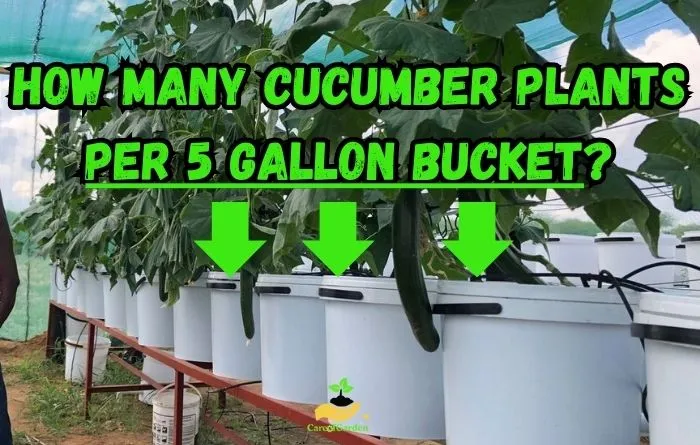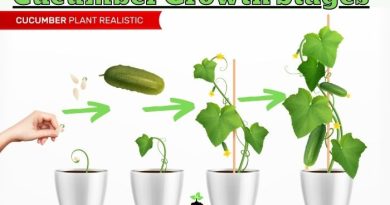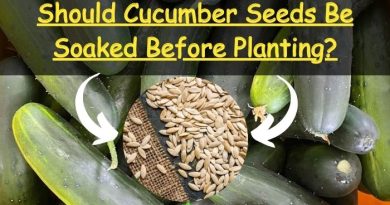How Many Cucumber Plants per 5 Gallon Bucket? Answered!
In this article, I want to share my personal experience with growing cucumber plants in a 5-gallon bucket. I have always been passionate about gardening and wanted to find a way to grow cucumbers even with limited space. After some research and experimentation, I discovered that using a 5-gallon bucket was a great solution.
One 5-gallon bucket can support one to two cucumber plants. While it may be tempting to try and squeeze in more plants, it’s important to give each of your cucumber plants enough space to grow and thrive.
How Many Cucumber Plants per 5 Gallon Bucket?
Based on my experience, I recommend planting one cucumber plant per 5 gallon bucket. This allows each plant enough space to grow and access the necessary nutrients and water for healthy development.
It ensures that each plant has enough room to receive adequate water and nutrients. By following the recommended guidelines of planting one cucumber plant per 5-gallon bucket, you can also easily manage and care for each plant individually.
While some gardeners may attempt to fit more cucumber plants in a single 5-gallon bucket, overcrowding can lead to stunted growth, reduced yields, and an increased likelihood of disease or pest issues.
Factors to Consider When Deciding How Many Cucumber Plants to Plant per Bucket
Here are the factors you should take into account when deciding how many cucumber plants to plant per bucket:
- Container Size: The 5-gallon container with dimensions of approximately 18 inches tall and 12 inches across is an ideal size for growing cucumbers. It provides enough space for one or two cucumber plants. Overcrowding should be avoided to allow proper growth.
- Support: Cucumbers are vining vegetables, so installing proper support, such as trellises, is essential. This support keeps the cucumbers off the ground, encourages vertical growth, and helps with air circulation.
- Cucumber variety: Choose a compact variety that is suitable for container gardening, such as the Bush Pickle or Spacemaster varieties. These varieties are better suited for growing in small spaces and may allow for more plants per bucket.
- Growing conditions: Cucumber plants require at least 6-8 hours of sunlight per day and warm temperatures to thrive. Make sure your plants are in a location that receives adequate sunlight and is protected from strong winds.
- Air Circulation: Cucumbers need good airflow to prevent diseases. Avoid overcrowding in the container to ensure that each plant receives adequate air circulation.
- Proper Soil: Use a well-draining organic potting mix rather than garden soil. This type of soil is lighter and better suited for container gardening.
- Moisture: Keep the soil consistently moist, especially during germination. Adequate watering is crucial for healthy cucumber growth.
- Fertilization: Cucumbers typically don’t need fertilizer until they have a couple of sets of true leaves. At that point, they can be fertilized every two weeks with a water-soluble fertilizer.
- Mulching: Mulching the top of the container helps conserve moisture and prevent soil from drying out. This is particularly important in containers, which can dry out more quickly than in-ground gardens.
- Thinning: Keep in mind that you may need to thin down the number of plants as they grow if they were initially planted in close proximity. Thinning helps prevent overcrowding and allows the remaining plants to thrive.
What Cucumber Varieties Grow Best in 5 Gallon Buckets?
When it comes to growing cucumbers in a 5-gallon bucket, choosing the right variety is crucial for a successful harvest. There are many different cucumber varieties to choose from, each with its own unique characteristics and growing requirements.
As someone who has grown cucumbers in containers before, I can tell you that some varieties are better suited for container gardening than others:
| Cucumber Variety | Description | Recommended for 5-Gallon Buckets |
|---|---|---|
| Bush Pickle Cucumber | Compact and bushy, perfect for containers. | Yes |
| Spacemaster Cucumber | Designed for small spaces, dwarf variety. | Yes |
| Patio Snacker | Dwarf cucumber, ideal for patios and buckets. | Yes |
| Salad Bush Cucumber | Compact and space-saving, good for containers. | Yes |
| Tiny Tim Cucumber | Small-fruited, dwarf cucumber for containers. | Yes |
| Picklebush Cucumber | Miniature pickling cucumber, compact size. | Yes |
| Muncher Cucumber | Compact vines, suitable for containers. | Yes |
| Spacemaster 80 | Compact and bushy, good for small gardens. | Yes |
| Fanfare Cucumber | Container-friendly cucumber with crisp fruits. | Yes |
| Dasher II | Bushy cucumber variety, suitable for pots. | Yes |
https://www.weekand.com/home-garden/article/grow-cucumbers-5gallon-bucket-18055942.php
These cucumber varieties are known for their compact growth habit, making them well-suited for container gardening in 5-gallon buckets.
Tips for Successful Cucumber Growing in 5-Gallon Buckets

Join me on a journey of my personal experience as I share my tips and tricks for success. We’ll explore how to prepare the bucket for optimal growth and discuss the best techniques for planting and spacing the cucumber plants.
1. Prepare the 5-gallon bucket for cucumber plants.
When it comes to growing cucumbers in a 5-gallon bucket, it is important to prepare the bucket properly to ensure that the plants have the best chance of thriving.
Here are a few steps to follow when preparing your 5-gallon bucket for cucumber plants:
- Choose a 5-gallon bucket: The first step is to choose a 5-gallon bucket that is sturdy and has no cracks or holes. You can purchase a new bucket from a hardware store or reuse an old one that has been thoroughly cleaned.
- Create drainage holes: It is important to create drainage holes in the bottom of the bucket to allow excess water to escape. You can use a drill or hammer and nail to create several small holes in the bottom of the bucket.
- Add a layer of rocks: Adding a layer of rocks or gravel to the bottom of the bucket will help with drainage and prevent soil from clogging the drainage holes.
- Fill with soil: Fill the bucket with a high-quality potting soil, leaving about 2-3 inches of space at the top.
- Water the soil: Before planting your cucumber plants, water the soil thoroughly to ensure that it is moist all the way through.
- Add fertilizer: Cucumber plants require a lot of nutrients to grow, so it is important to add a slow-release fertilizer to the soil before planting. You can also add compost or other organic matter to help improve soil quality.
- Plant your cucumber plants: Finally, it is time to plant your cucumber plants. You can plant one or two plants per bucket, depending on their size and how much space they need to grow. Make sure to plant them deep enough so that the soil covers the roots.
2. Prepare the soil and compost
From my experience, I have found that the ideal soil mix for growing cucumbers in a container is a well-draining potting mix that is rich in organic matter.
To prepare the soil, I start by filling the bottom of the 5-gallon bucket with a layer of gravel or rocks. This helps to improve drainage and prevent water from pooling at the bottom.
Next, I fill the bucket with a potting mix that is made up of equal parts of potting soil, compost, and perlite. The potting soil provides the necessary nutrients for the plants, while the compost helps to retain moisture and improve soil structure. The perlite helps to improve drainage and prevent the soil from becoming waterlogged.
In addition to the potting mix, I also add a layer of mulch on top of the soil. This helps to retain moisture, suppress weeds, and regulate soil temperature. I prefer to use organic mulch, such as straw or shredded leaves, as it breaks down over time and adds nutrients to the soil.
When it comes to compost, I prefer to use a high-quality compost that is made up of a variety of organic materials, such as vegetable scraps, grass clippings, and leaves. I avoid using compost that is made up of animal manure, as it can be too high in nitrogen and can burn the plants.
It is important to ensure that the soil temperature is warm enough for cucumber seeds to germinate. The ideal soil temperature for cucumber seeds is between 70-90°F. To achieve this, I place the buckets in a warm, sunny location and cover them with a plastic sheet or a cloche to retain heat.
3. Plant your cucumber seeds
Here are my steps on how to plant the cucumber seeds in a 5-gallon bucket:
- Fill the bucket with potting soil up to about 2 inches below the rim.
- Moisten the soil with water until it is damp but not waterlogged.
- Make small holes in the soil about 1 inch deep and 3 inches apart using your finger or a pencil.
- Drop one or two cucumber seeds into each hole.
- Cover the seeds with soil and gently press down to ensure good soil-to-seed contact.
- Label the bucket with the cucumber variety and the date of planting.
- Water the seeds gently, being careful not to disturb the soil.
Cucumber seeds need warm soil to germinate, so keep the bucket in a warm, sunny spot. The ideal temperature for cucumber seed germination is between 70 and 90 degrees Fahrenheit.
After a few days, the cucumber seeds should start to sprout, and you will see seedlings emerging from the soil. At this point, you should thin out the weaker seedlings, leaving only the strongest one in each hole. This will prevent overcrowding and ensure that the remaining seedlings have enough space to grow.
It’s important to keep the soil moist but not waterlogged during the seedling stage. Overwatering can cause the seeds to rot, while underwatering can cause the seedlings to wilt and die. Water the seedlings when the top inch of soil feels dry to the touch.
In about 2 to 3 weeks, the cucumber seedlings should be big enough to transplant into the 5-gallon bucket.
4. Proper watering and drainage
To optimize both watering and drainage, it is advisable to utilize a well-draining soil mix specifically designed for container gardening. This type of soil mix allows excess water to drain freely while retaining adequate moisture for the cucumber plants. Along with regular watering, it is also essential to mulch around the cucumber plants with organic materials like straw or grass clippings.
This helps to conserve moisture and reduce water evaporation. Proper watering and drainage practices play a critical role in maintaining the health and productivity of cucumber plants.
To prevent waterlogging, it is recommended to have drainage holes in the bottom of the 5-gallon bucket to allow excess water to escape, thus avoiding water pooling and root issues.
5. Providing sufficient nutrients
Providing sufficient nutrients is crucial for successful cucumber growth in 5-gallon buckets. To ensure your cucumber plants receive the necessary nutrients, follow these steps:
- Opt for a high-quality potting mix or soil that contains added organic matter. This will serve as a solid foundation for nutrient absorption.
- Enrich the soil with essential nutrients by incorporating organic compost or well-rotted manure.
- Use a balanced fertilizer specifically designed for vegetables, following the recommended dosage instructions provided on the package.
- Make sure the fertilizer contains key nutrients like nitrogen, phosphorus, and potassium, which support healthy growth, flowering, and fruit development.
- Monitor the soil’s pH level and adjust it if needed. Cucumber plants thrive in a slightly acidic to neutral pH range of 6.0 to 7.0.
6. Supporting and training cucumber plants
Supporting and training cucumber plants in a 5-gallon bucket is crucial for their proper growth and productivity. To achieve this, follow these steps:
- Install a trellis or stake: Cucumber plants are climbing vines and require support to grow upright. Before planting the cucumbers, place a trellis or stake in the bucket.
- Tie the main stem: As the cucumber plant grows, use soft plant ties to loosely tie the main stem to the trellis or stake. This will help maintain its upright position and prevent sprawling on the ground.
- Prune lateral branches: Regularly check for lateral branches or suckers that grow between the main stem and leaf nodes. By pruning these branches, you will direct the plant’s energy towards producing larger and better cucumbers.
- Guide the main stem: Encourage vertical growth of the main stem by gently guiding it along the trellis or stake. This promotes better airflow around the plant, reduces the risk of diseases, and simplifies the cucumber harvesting process.
- Remove yellowed or damaged leaves: Keep a close watch on the cucumber plant and promptly remove any yellowed or damaged leaves. This prevents the spread of diseases and allows the plant to focus its energy on productive growth.
Can I Grow Cucumber Plants Upside Down in a 5 Gallon Bucket?
Yes, you can grow cucumber plants upside down in a 5-gallon bucket. Here are the steps to do it:
- Choose a sturdy 5-gallon bucket with a lid to hold the soil and plant.
- Drill or cut a hole in the bottom of the bucket for the plant to grow out from.
- Insert the cucumber plant through the hole in the bottom of the bucket, so the plant hangs upside down.
- Fill the bucket with well-draining potting soil, ensuring the root ball of the plant is covered.
- Water the plant thoroughly, ensuring that the soil is moist but not waterlogged.
- Hang the bucket in a sunny location where the plant will receive at least 6-8 hours of direct sunlight per day.
- Monitor the moisture levels in the soil and water the plant regularly to keep the soil evenly moist.
- Provide support for the cucumber plant to grow along, such as a trellis or stakes.
- Prune the plant regularly to remove any dead or diseased foliage and to promote better airflow.
How Often Should I Fertilize Cucumber Plants in 5 Gallon Buckets?
According to gardening experts, you should fertilize cucumber plants in 5-gallon buckets at least once every two weeks to ensure they have the nutrients they need to grow and produce fruit. When fertilizing cucumber plants, it’s recommended to use a balanced fertilizer with a 10-10-10 NPK ratio or a liquid fertilizer with a 20-20-20 NPK ratio.
However, it’s important not to over-fertilize your plants, as this can lead to nutrient burn and damage to the roots.
Always follow the instructions on the fertilizer package and monitor your plants for signs of stress or nutrient deficiencies.
Key takeaways:
- Choosing the right cucumber variety is important when growing cucumber plants in a 5-gallon bucket.
- Factors such as the size and vigor of cucumber plants, climate and growing conditions, and growth habit of the cucumber variety need to be considered when determining the number of cucumber plants per 5-gallon bucket.
- Proper watering and drainage, providing sufficient nutrients, and supporting and training cucumber plants are essential for successful cucumber growing in 5-gallon buckets.
Frequently Asked Questions
How many cucumber plants can I grow in a 5-gallon bucket?
One 5-gallon bucket can support one cucumber plant. While it may be tempting to try and squeeze in more plants, it’s important to give each plant enough space to grow and thrive. Overcrowding can lead to stunted growth and poor yields.
What are the spacing requirements for cucumber plants in a container?
Cucumber plants need at least 12 inches of space between each other, so if you are planting multiple plants, make sure to use containers that are large enough to accommodate them.
What are the steps to grow cucumber plants in a 5-gallon bucket?
To grow cucumber plants in a 5-gallon bucket, follow these steps:
- Drill holes at the bottom of the bucket for water drainage.
- Place the bucket in a sunny location.
- Fill the bucket with potting soil.
- Plant the cucumber seeds and cover them with soil.
When should I water my cucumber plants in the 5-gallon bucket?
Water each cucumber plant every 10-14 days to maintain adequate moisture.
Can I grow other vegetables in a 5-gallon bucket?
Yes, you can grow various vegetables in a 5-gallon bucket such as chili peppers, kale, lettuce, onions, tomatoes, spinach, radishes, and sweet peppers.
What is the recommended temperature for growing cucumbers in a 5-gallon bucket?
The temperature should always be below 90 degrees Fahrenheit to ensure the optimum growth of cucumber plants.




